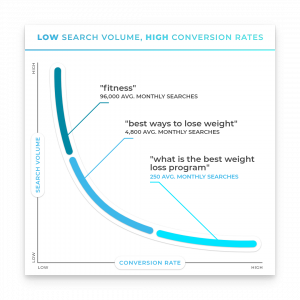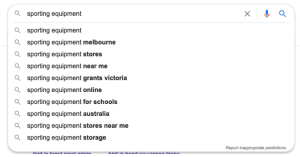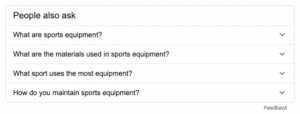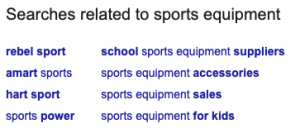In this comprehensive SEO guide, we’ll explore what exactly a long-tail keyword is alongside their benefits, how to search for them, key examples and more.
- What are long-tail keywords?
- Long-tail keywords vs. short tail keywords
- Benefits of long-tail keywords and why you should focus on them
- The consumer purchase process & long-tail keywords
- How to use long-tail keywords
- How to find long-tail keywords
- Using SEO tools to find long-tail keywords
- How to search for long tail keywords using competitors
- StudioHawk’s expert SEO services
What are long-tail keywords?
You may be wondering, what exactly is a long-tail keyword? Long-tail keywords are keywords or phrases that are more specific than commonly searched keywords. For example, if you were looking for an article on long-tail keywords, a large volume of people would just type ‘long-tail keywords’ into Google search. But what about all the individuals that typed in something different, like these below:
- What is a long-tail keyword?
- Long-tail keyword research tool
- Long-tail keyword examples
- How to use long-tail keywords
- How to find long-tail keywords
These specific searches are examples of long-tail keywords and are often missed by websites that pour their focus into high search volume ‘seed keywords’, which are broad, umbrella search terms. Users that type in something specific portrays motivation and quite often can lead to a sale. Let’s dive into how you can convert these search terms into profit.
Long-tail keywords vs. short tail keywords
In comparison to long-tail keywords, short tail keywords are broader, generic, more popular terms that are shorter in length (hence the name), being no more than three words long. Whilst short-tail keywords generally have higher search volumes, they tend to have more competition, making it harder to rank for them in the search results.
Benefits of long-tail keywords and why you should focus on them
It’s straightforward really; specific searches and long-tail keywords are less competitive. A recent study has shown that out of 1.9 billion search queries, 92% had less than ten searches a month. If a query has only ten searches a month, it has to be specific. This 92% is how long-tail keywords received their title.

You can see that although the red zone has a large volume of monthly searches, the number of search queries that fall under ten per month, stretches off the graph like a “long-tail”.
By ranking for a large number of queries with little to no competition, you can generate the same kind of traffic as a company that is spending bucket loads of cash on their SEO.
Another contributing factor to the benefits of using long-tail keywords is their conversion rate. Low search volume = high conversion rate. Why is this? Specific search queries portray motivation. The consumer is actively searching for a particular product in comparison to vaguely researching a wide range of products.
The consumer purchase process & long-tail keywords
It’s vital to know what long-tail keywords are and how to use them because if you are just trying to rank for popular keywords because of the large search volume, your website may not end up ranking or performing well at all. However, it does not mean that you shouldn’t invest into your seed keywords – these are essential! Seed keywords are responsible for the early stages of the six-step process a consumer goes through before making a purchase. Let’s have a look at the six steps.
1. Consumer hears about a product.
This can happen through many avenues, for example; word of mouth, seeing it in passing, practical needs, advertising, curiosity. It could be any number of reasons, the fact of the matter is that they are interested in the product.
2. The consumer actively searches for the product online.
Of course, some people may look for the product physically but that is unrelated to the subject.
3. Consumer compares different products, through pricing, quality, branding etc.
This is where a great website layout comes into effect, assisting in making the customer’s life easy.
4. The consumer decides which product they will purchase
Now around step four, customers start using long-tail keywords, they have specifically decided what product, brand and price they want; in effect, their google search will involve those details. These are the long-tail keywords that slip through the cracks, that don’t get searched that often but often enough lead to a sale.
5. The transaction is complete.
6. The product is evaluated upon delivery.
It’s one thing learning about why long-tail keywords are essential, but it’s another ball game putting it into practice. Let’s go through how you can make it happen.
How to use long-tail keywords
To dive into how to use long-tail keywords for your website, let’s look at an example.
For example, if you were the owner of a sports store, your seed keyword would be ‘sporting equipment’. However, by limiting yourself to people only searching for ‘sporting equipment’, you will be competing against other sports stores and retailers who are also fighting to rank for the keyword on ‘sporting equipment’.
Using ‘sports equipment’ as the seed keyword, we can use SEO tools (which we will dive into later on) to find related long-tail keywords, for example:
- soccer equipment
- the best basketball equipment
- winter sports equipment
- what is the bacterial spray for sports equipment
- what are the best brands to use for golfing

Using the infographic above, the seed keyword is ‘fitness’, but delving deeper, we can see that there are related long-tail keywords: “best ways to lose weight”, which has 4,800 searches per month, and “what is the best weight loss program”, which has 250 searches per month.
When your pages, articles and/or blogs are written, ensure you are using these non-competitive searches to maximise organic traffic. But how do you find them?
How to find long-tail keywords
There are a few ways you can find them. A quick and easy way is to type the beginning of your keyword suggestion into google search and see what comes up in predictions.  This will give you some basic keyword suggestions and a general idea of what people are looking for concerning your head term.
This will give you some basic keyword suggestions and a general idea of what people are looking for concerning your head term.
If you search for ‘sporting equipment’ and scroll down, you will eventually find the ‘People also ask for’ box. This can help you find the long-tail keyword questions that Google registers frequently.

At the bottom of the page of your results for ‘sports equipment’, you’ll find ‘Related Searches’.

These methods of tracking long-tail keywords aren’t exactly accurate because there is no data backing up their productivity. You could have a whole article written on one of the suggestions in aim to generate organic traffic, to find that it’s incredibly tough to rank for. To go into depth, you need an SEO tool.
Using SEO tools to find long-tail keywords
SEO tools can optimise your web page by offering great insights into keywords. Using these tool will save you a whole lot of time filtering through google search results and also maximise your investment by providing data. In this specific example, we have used SEMRush. SEMRush is a great SEO tool that offers a variety of analytics tools and helpful insight into whether providing your website is generating the traffic that it deserves.

By using the Keyword Magic Tool, you can search the database to find long-tail keyword suggestions that have a low level of difficulty and that with the right web page you could shoot to number one!
![]()
At the top of the graph, it shows you how many people are searching for the keyword (volume) and how hard it will be to rank for (KD%).
How to search for long tail keywords using competitors
Another tool that will help you in finding long-tail keywords is looking at what other competitors are ranking for. Here are some easy steps on how you can use SEMRush to find long-tail keywords.
Step 1.
Type in a term or phrase that you ideally want your website to rank number one for and see what competitors are on the first page. In the example given, the long-tail keyword searched was ‘best sports equipment for soccer’.
Step 2.
Copy and paste the URL of your choosing; it’s best to pick out of the top five as humans quite often avoid scrolling down the page. In the example, position No. 1 was chosen – https://www.networldsports.com.au/soccer/training-equipment.html
Step 3.
Go into Semrush – Domain Analytics – Overview, then copy and paste the URL into the search bar.


The overview will show you all the relevant keywords the site is ranking for and ultimately making them money. It will also show you their competitors and what they are ranking for alongside a lot more data and analysis.
StudioHawk’s expert SEO services
The process of finding, using and analysing long-tail keywords can be daunting. At StudioHawk, we encourage businesses to involve their understanding of the inner-workings of SEO. By executing these tasks that you once thought were impossible, you can use the money saved and reinvest into other avenues of the business.
StudioHawk is a Specialist SEO Company focused on one thing, building SEO campaigns that get you to the front page of Google. Our comprehensive keyword research is crucial for setting up a strong campaign, so we make sure to get it right.
Get in touch with one of our SEO specialists today to learn more about our SEO services and how we can get you ranking for your target long-tail keywords.